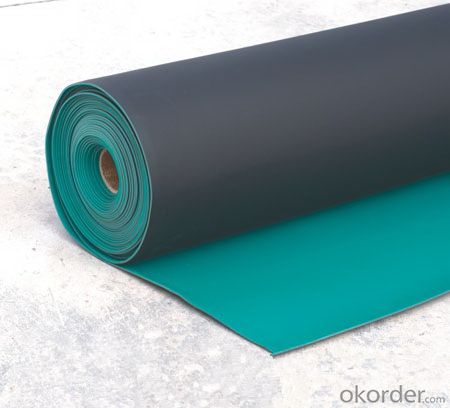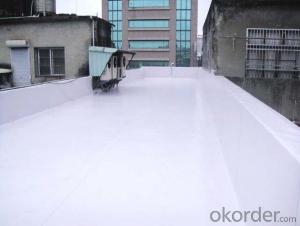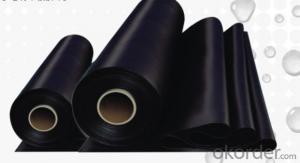Polyvinyl Chloride (PVC) waterproofing membrane
- Loading Port:
- Qingdao
- Payment Terms:
- TT OR LC
- Min Order Qty:
- 20000 m²
- Supply Capability:
- 600000 m²/month
OKorder Service Pledge
OKorder Financial Service
You Might Also Like
1.Introduction of Polyvinyl Chloride (PVC) waterproofing membrane:
Polyvinyl Chloride (PVC) waterproofing membrane is a new polymer waterproof membrane which is made from polyvinyl chloride resin, and mixed with plasticizer,filler, antioxygen, ultraviolet absorber and other auxiliaries. DHK-8100 adopts automatic mixing of raw material, double-screw extruder and delicate three-roller calender equipment in the PVC membrane production. DHKchem PVC waterproof membrane features dimensional stability and high tensile strength, being a best choice for many civil and industrial project.
2.Physical data of Polyvinyl Chloride (PVC) waterproofing membrane:
No | Item | I | II | |
1 | Tensile strength/ Mpa | 8.0 | 12.0 | |
2 | Fracture elongation / % ≥ | 200 | 250 | |
3 | Heating flexibility / % ≤ | 3.0 | 2.0 | |
4 | Cold bending | -20°C No leaking | -25°C No leaking | |
5 | Water impermeability | Water impermeable | ||
6 | Binding property with cutting (N/mm) | 3.0/ breaking membrane | ||
7 | Hot air ageing | Appearance | No craze, no bubble, no cohering, hole | |
Tension strength % | ±25 | ±20 | ||
Fracture elongation changing rate | ||||
Cold bending % | -15°C No leaking | -20°C No leaking | ||
8 | Chemistry corrosion resistance | Tension strength % | ±25 | ±20 |
Fracture elongation changing rate | ||||
Cold bending % | -15°C No leaking | -20°C No leaking | ||
9 | Phytotrons accelerating ageing | Tension strength % | ±25 | ±20 |
Fracture elongation changing rate | ||||
Cold bending % | -15°C No leaking | -20°C No leaking | ||
10 | Note: no considering phytotrons accelerating ageing. | |||
3.Chatacteristics of Polyvinyl Chloride (PVC) waterproofing membrane:
Excellent performance in aging resistance, service life of 20 years for exposed use, and 50 years for non-exposed application.
Easy installation and hot-air welding seam, environmental friendly.
High tension, perfect elongation, perfect heating resistance.
Excellent jointing, it can be fused with base as a whole after heating jointing.
High permeability, chilling material and moisture can be expelled easily.
High UV resistance , corrosion resistance and erosion resistance.
High cold flexibility (-20°C).
Surface can reflect UV. The temperature on the surface is low due to little absorbing heat.
4.Application of Polyvinyl Chloride (PVC) waterproofing membrane:
Colorful polymer PVC waterproof membrane can variously be used on the roof of building, underground building, tunnel, dam, pool, sewage treatment works, and garbage disposal facilities. It also can be suitable to any requirement of all kinds of technological practice & different grade of roof waterproof and underground constructions waterproof.


- Q:Can a waterproofing membrane be used on zinc surfaces?
- Yes, a waterproofing membrane can be used on zinc surfaces. Zinc is a durable and corrosion-resistant material commonly used in various applications, including roofing and cladding. Applying a waterproofing membrane on zinc surfaces can provide an additional layer of protection against water intrusion and moisture damage. It can help prevent leaks, extend the lifespan of the zinc surface, and maintain its overall integrity. However, it is important to ensure that the waterproofing membrane is compatible with zinc and specifically designed for such applications. It is recommended to consult with a professional or manufacturer to determine the best waterproofing solution for zinc surfaces.
- Q:Can a waterproofing membrane be used on roofs with rooftop gardens?
- Indeed, rooftops with gardens can benefit greatly from the utilization of a waterproofing membrane. Employing a waterproofing membrane is strongly advised as it shields the foundational framework from harm caused by water. Given that a rooftop garden contributes additional weight and moisture to the roof, it is imperative to have a reliable waterproofing system in place to avert leaks and guarantee the roof's durability. The waterproofing membrane serves as a safeguard against water infiltration, effectively maintaining dry conditions for both the rooftop garden and the underlying structure.
- Q:What are the proper installation techniques for a waterproofing membrane?
- To ensure effective and long-lasting protection against water infiltration, proper installation techniques for a waterproofing membrane involve a series of steps. Here are some guidelines: 1. Start by preparing the surface. It is crucial to have a clean and smooth substrate. Eliminate any loose debris, dirt, or previous coatings. Before moving forward, make sure to repair any cracks or imperfections in the surface. 2. Enhance adhesion between the substrate and the waterproofing membrane by applying a suitable primer. The primer should be compatible with both the substrate material and the membrane. 3. Select a waterproofing membrane that suits the specific application and site conditions. There are different types available, such as sheet membranes, liquid-applied membranes, and self-adhesive membranes. Consider factors like the substrate material, expected movement or stress, and exposure to chemicals or UV radiation. 4. Install the membrane. The exact method may depend on the type of membrane used, but the following general steps apply to most installations: a. Carefully unroll or unfold the membrane, avoiding wrinkles or folds. b. Position the membrane onto the primed surface, ensuring it extends beyond the desired waterproofed area. c. Firmly press the membrane onto the substrate using a roller or trowel, ensuring good contact and eliminating air pockets. d. Overlap the edges of adjacent membrane sheets or sections according to the manufacturer's instructions, typically around 2-3 inches. e. Seal the overlaps securely by applying a suitable seam or joint adhesive. 5. Perform testing and inspection. After installation, it is essential to conduct a comprehensive quality control check. Conduct a flood or water test to verify the membrane's effectiveness in repelling water and to identify any leaks or defects. 6. Protect and finish the installed membrane. Prevent damage during construction activities and enhance durability and resistance to UV radiation or mechanical stress by applying necessary protection layers or coatings. 7. Maintain and repair. Regularly inspect the waterproofing membrane and promptly address any signs of damage, wear, or deterioration. Follow the manufacturer's guidelines for maintenance and perform necessary repairs as soon as possible to maintain the membrane's effectiveness. It is always advisable to consult with a professional waterproofing contractor or follow manufacturer recommendations for the specific membrane being used, as installation techniques can vary.
- Q:Can a waterproofing membrane be used for a planter box waterproofing?
- Yes, a waterproofing membrane can be used for planter box waterproofing. A waterproofing membrane is designed to create a barrier against water and moisture, preventing it from seeping through the surface it is applied to. This makes it an ideal choice for planter box waterproofing, as it helps to protect the structure of the planter box and prevent water damage. The membrane can be applied to the interior of the box, creating a watertight seal that prevents water from leaking out or causing damage to the surrounding surfaces. Additionally, a waterproofing membrane can also help to extend the lifespan of the planter box by preventing the growth of mold or mildew, which can be caused by excess moisture. Overall, using a waterproofing membrane for planter box waterproofing is a practical and effective solution to ensure the longevity and durability of the planter box.
- Q:Can waterproofing membranes be used on concrete pipes?
- Yes, waterproofing membranes can be used on concrete pipes. These membranes provide a protective barrier against water infiltration, preventing any potential leakage or damage to the concrete pipes.
- Q:Waterproof membrane in the escape when the full shop, empty shop, shop, shop what is the difference?
- Coil construction process: 1, full of paving the film, the membrane and the base layer with all sticky.
- Q:Are waterproofing membranes suitable for residential applications?
- Yes, waterproofing membranes are suitable for residential applications. They are commonly used in various areas of residential construction, such as basements, foundations, roofs, bathrooms, and balconies, to prevent water penetration and protect the building structure from moisture damage. Waterproofing membranes provide a barrier against water, preventing it from seeping into the structure and causing issues like mold, rot, or structural damage. These membranes are typically made of materials like bitumen, PVC, EPDM, or polyurethane, which are highly effective in repelling water. In residential constructions, waterproofing membranes are installed during the building process or as a part of renovation projects. They can be applied as a liquid coating or in the form of sheets that are laid down and adhered to the surface. These membranes create a seamless and durable barrier that can withstand the test of time. Additionally, waterproofing membranes offer various benefits for residential applications. They help maintain a dry and comfortable living environment by preventing water leaks and dampness. This, in turn, protects the integrity of the building materials, prolongs the lifespan of the structure, and reduces the risk of costly repairs. Furthermore, waterproofing membranes can also enhance energy efficiency by reducing moisture-related heat loss or gain. By preventing water infiltration, they help maintain consistent temperatures inside the house, resulting in lower energy consumption and utility bills. Overall, waterproofing membranes are an excellent choice for residential applications. They provide reliable protection against water damage, improve the longevity of the structure, and contribute to a healthier and more energy-efficient living environment.
- Q:Can a waterproofing membrane be used for elevator pits or sump pits?
- Yes, a waterproofing membrane can be used for elevator pits or sump pits. Elevator pits and sump pits are areas that are prone to water intrusion, so it is important to protect them from water damage. A waterproofing membrane is designed to create a barrier against water, preventing it from seeping into the pits and causing damage to the structure or equipment. By applying a waterproofing membrane to the walls and floors of elevator pits or sump pits, it helps to keep the area dry and free from water infiltration. This can help extend the lifespan of the elevator or sump pump system and prevent costly repairs in the future. It is important to properly install and maintain the waterproofing membrane to ensure its effectiveness and longevity.
- Q:Are waterproofing membranes resistant to seawater?
- Yes, waterproofing membranes are resistant to seawater. These membranes are designed to provide a barrier against water and are specifically engineered to withstand the harsh conditions of seawater. They are made from materials that are highly resistant to saltwater corrosion and are tested to ensure their effectiveness in preventing water penetration, including the corrosive effects of seawater. This makes waterproofing membranes an ideal choice for applications where seawater exposure is a concern, such as in marine structures, coastal buildings, and swimming pools.
- Q:Can a waterproofing membrane be used for a sports facility?
- Yes, a waterproofing membrane can be used for a sports facility. Waterproofing membranes are commonly used to protect buildings and structures from water damage, including sports facilities. They can be applied to various surfaces such as roofs, walls, and floors to prevent water infiltration and ensure a dry and safe environment for athletes and spectators.
1. Manufacturer Overview |
|
|---|---|
| Location | |
| Year Established | |
| Annual Output Value | |
| Main Markets | |
| Company Certifications | |
2. Manufacturer Certificates |
|
|---|---|
| a) Certification Name | |
| Range | |
| Reference | |
| Validity Period | |
3. Manufacturer Capability |
|
|---|---|
| a)Trade Capacity | |
| Nearest Port | |
| Export Percentage | |
| No.of Employees in Trade Department | |
| Language Spoken: | |
| b)Factory Information | |
| Factory Size: | |
| No. of Production Lines | |
| Contract Manufacturing | |
| Product Price Range | |
Send your message to us
Polyvinyl Chloride (PVC) waterproofing membrane
- Loading Port:
- Qingdao
- Payment Terms:
- TT OR LC
- Min Order Qty:
- 20000 m²
- Supply Capability:
- 600000 m²/month
OKorder Service Pledge
OKorder Financial Service
Similar products
New products
Hot products
Hot Searches
Related keywords






























